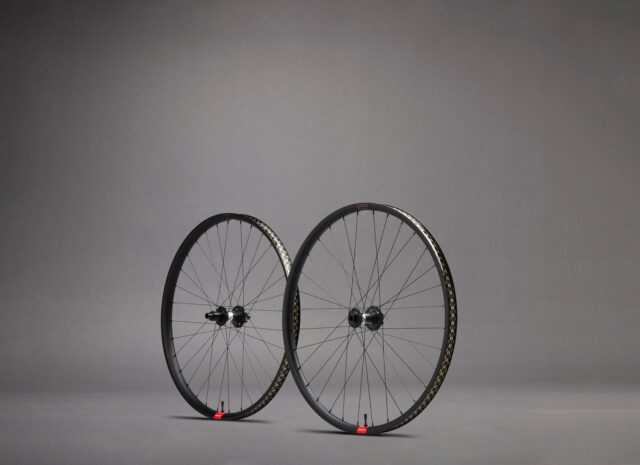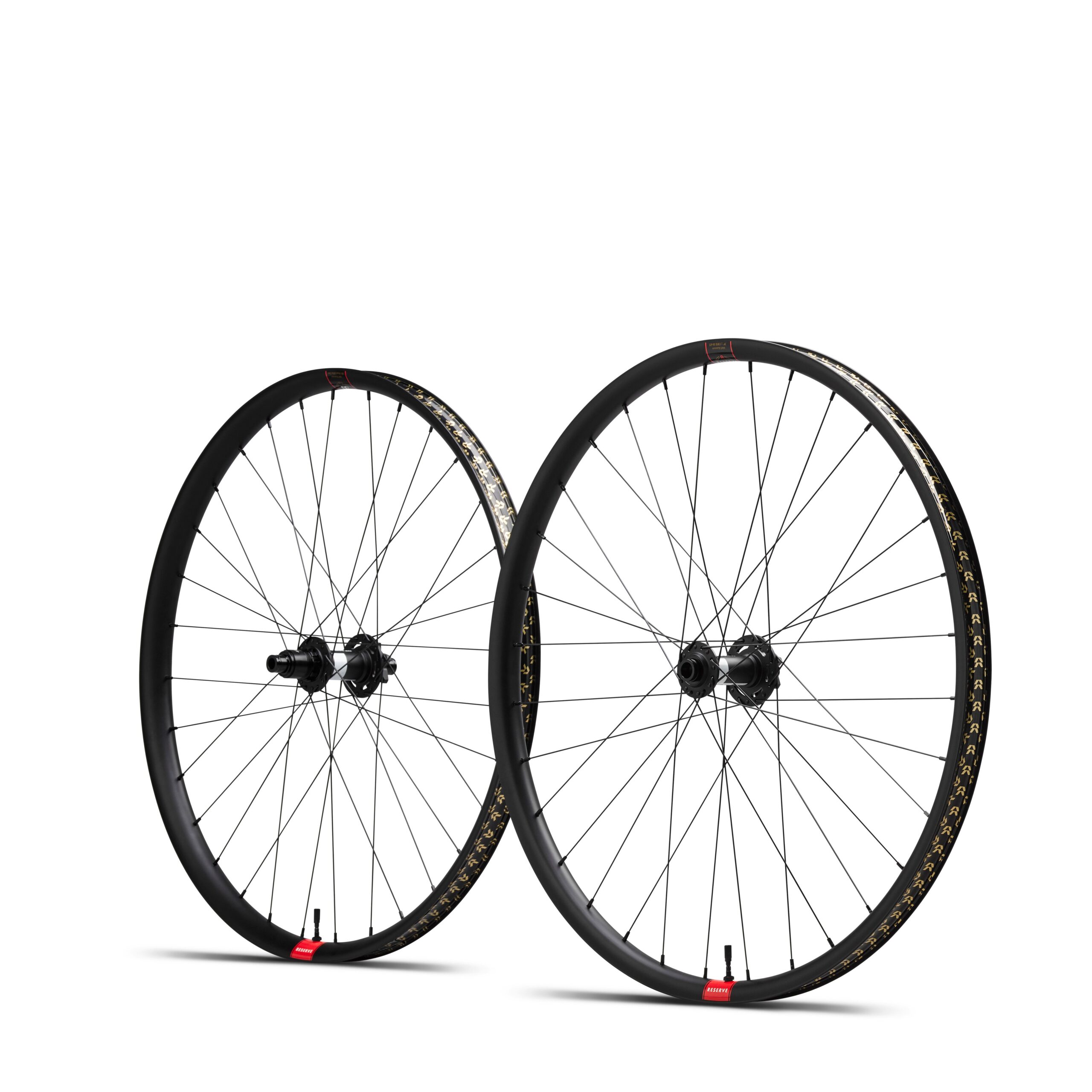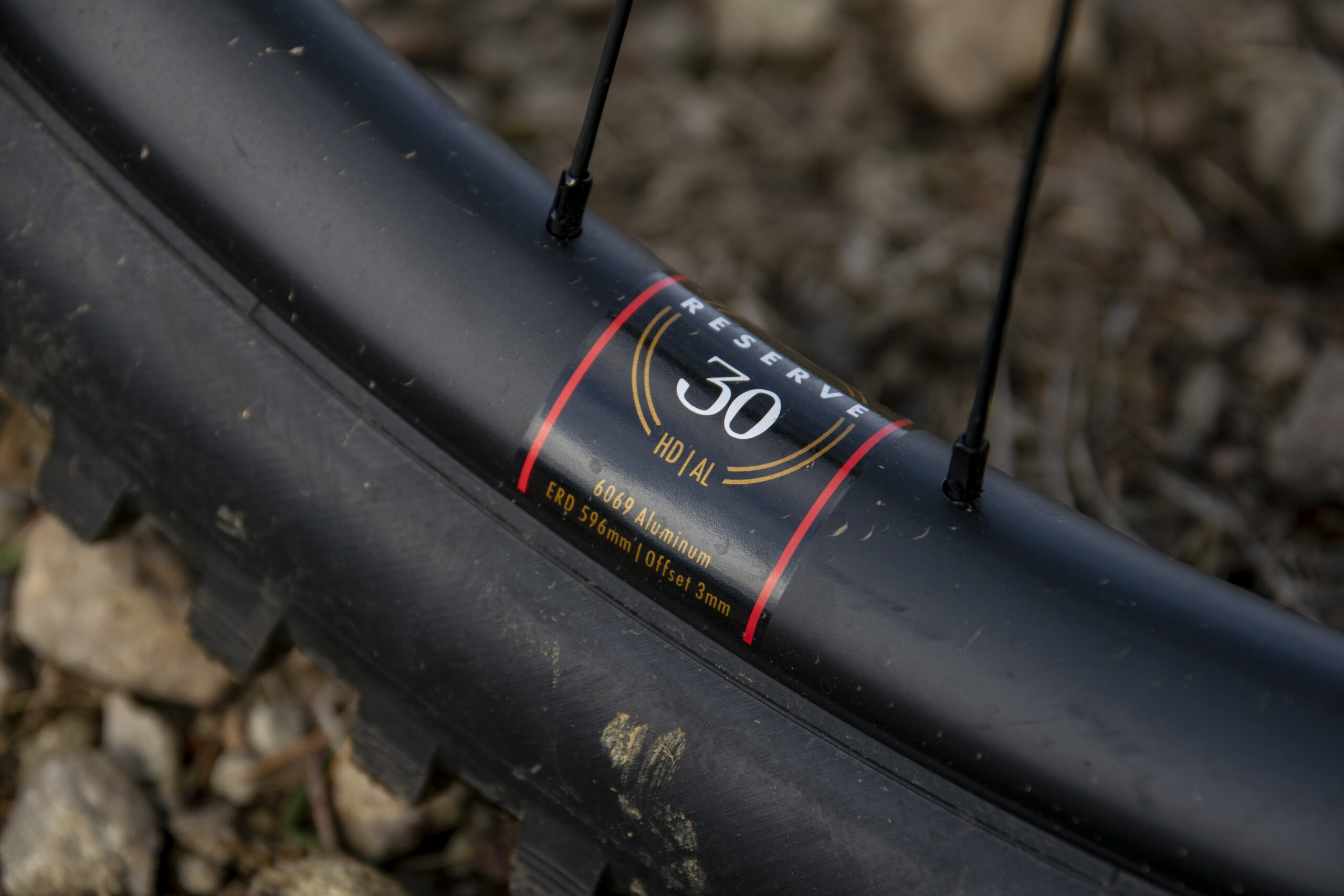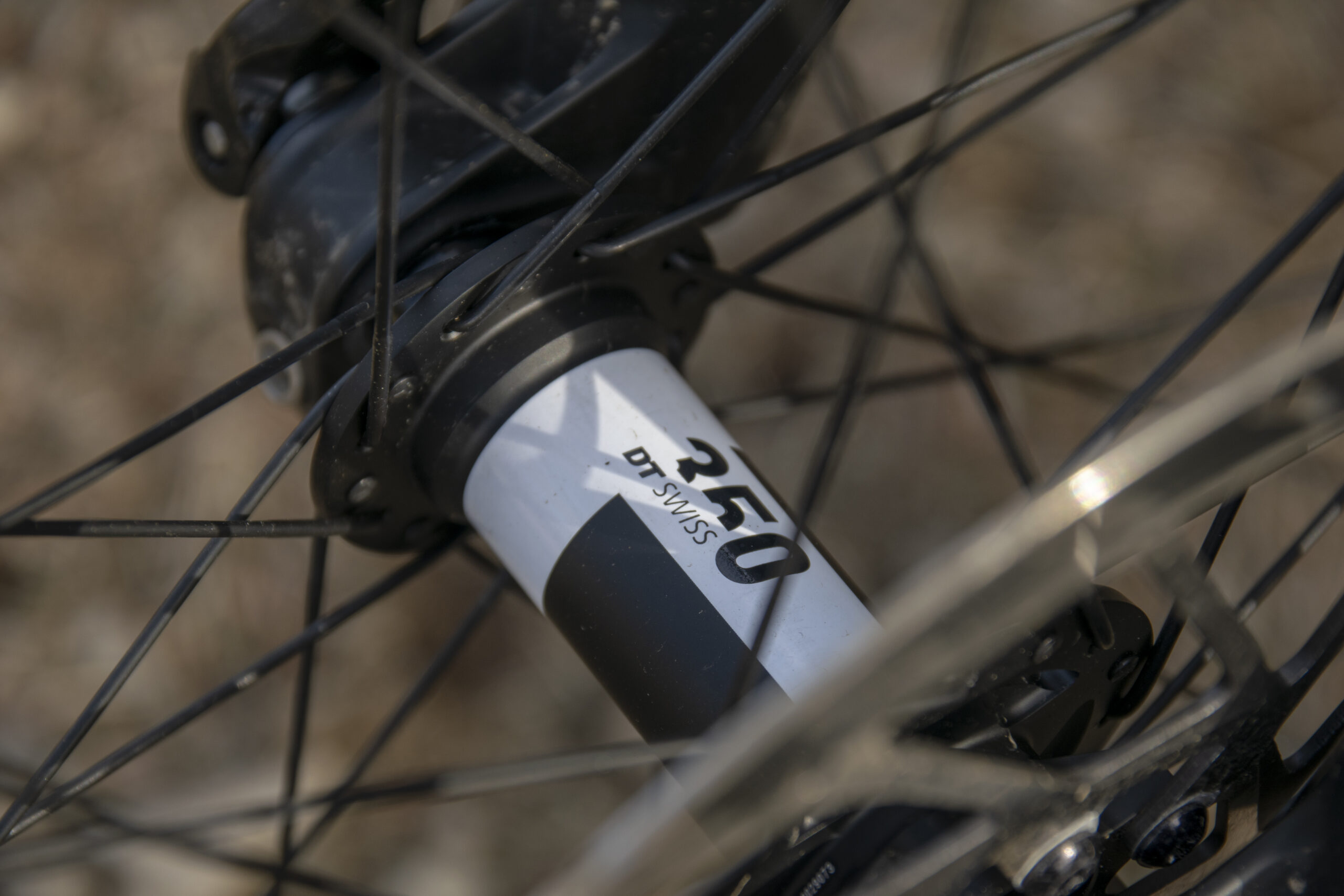- Reserve 30|SL & 30|HD AL Wheels
Internal Width: 30 mm
Sizes Available: 27.5’’ and 29’’
Material: Aluminum
Stated weight:
- 30|SL AL rim: 460 g (27.5’’) / 500 g (29’’)
- 30|HD AL rim: 540 g (27.5’’) / 580 g (29’’)
- 30|SL AL wheelset: 1,840 g
- 30|HD AL wheelset: 1,920 g
Blister’s Measured Weight (30|HD AL wheelset, 29’’, w/ pre-installed rim tape):
- Front: 1,002 g
- Rear: 1,102 g
- Total: 2,104 g
MSRP:
- Wheelset w/ DT Swiss 350 hubs: $699
- DH wheelset w/ Industry 9 1/1 hubs: $699
- Rim only: $150

Intro
Reserve has long been synonymous with carbon fiber wheels, but now they’re entering the aluminum wheel game with two new models, the 30|SL AL and 30|HD AL. As the names would suggest (and mirroring the naming scheme of their carbon counterparts), the pair are meant for Trail and Enduro bikes, respectively, with the SL version coming in substantially lighter than the burlier HD. And while there are a lot of good aluminum wheels out there already, there are some interesting details that still manage to set the Reserve options apart.

Design
Though the rim material is new for them, a lot of the design elements of these aluminum wheels are typical for Reserve. Both the 30|SL AL and 30|HD AL have, unsurprisingly, a 30 mm internal width, with an asymmetric profile that offsets the spoke holes by 3 mm from the rim centerline (flipped between the drive and non-drive sides) for more even spoke bracing angles and tension.
The inner profile of the new wheels is also quite similar to that of their carbon counterparts, with a notably deep center channel but relatively large, flat bead seat areas (especially on the side away from which the spokes are offset) and a shallow notch for the bead to settle into for extra retention. And as with the carbon wheels, the 30|SL AL and 30|HD AL share the same basic inner profile, but with some extra material added to beef up the HD version, which of course comes at the expense of some weight.

The two alloy options also differ in terms of spoke count, with the 30|SL AL getting 28 per wheel, and the HD version bumping that up to 32. And at least to start, the new rims are only available as a complete wheelset with DT Swiss 350 hubs and Sapim spokes, for $699 a set.
[Update: Reserve has since added a version of the 30|HD AL with Industry Nine 1/1 hubs in 110 x 20 / 157 x 12 mm DH spacing for the same $699, and a rim-only offering for $150; the 30|SL AL is still only offered with DT 350 hubs as part of a complete wheelset.]
There are certainly cheaper options out there, but the DT hubs are especially robust, and Reserve isn’t cutting corners on the spokes, either. But what makes that price a whole lot more impressive is the next part:
Reserve was early to offer a lifetime warranty for the original owner on their carbon wheels — now a common feature from a lot of brands — and they’re doing the same for their aluminum offerings, including damage suffered while riding. One of the big selling points of carbon wheels has been increased rim durability, which has helped lifetime warranties proliferate for those options, but there aren’t many aluminum wheels offering anything comparable. The rubric for how damage is categorized is as follows:
- Dented rim, no paint chipping, holding air: Crash replacement
- Dented rim, paint chipping: Warranty
- Dented rim, not holding air: Warranty
- Seam separation: Warranty
- Crack at spoke hole: Warranty
All that is to say that Reserve isn’t trying to hand out new rims for minor damage, but if you induce enough carnage to cause a real problem, they’ll take care of you. For cases that don’t qualify for warranty, the crash replacement will be offered at 50% of retail pricing, and Reserve will ship out complete replacement wheels when possible, with a replacement rim and a service credit for re-lacing them as a fallback.

Weight (and Comparisons)
Reserve’s claimed weights of 500 g and 580 g for the 30|SL AL and 30|HD AL rims, respectively in a 29’’ diameter, are pretty typical for an aluminum rim in their respective classes. The 80 g claimed difference in wheelset weight (the diameter for that isn’t specified) is harder to square, given the added 80 g of weight per rim, plus four extra spokes and nipples per wheel. Indeed, our test set of 30|HD AL wheels are coming in significantly heavier than claimed, at 2,104 g for the pair; the claimed weight of 1,840 g for the 30|SL AL wheelset sounds about right based on those differences and our measured weight of the 30|HD ALs.
For reference, below we’ve got the weights of a bunch of competitive rims and wheels. They’re all for a 29’’ diameter unless otherwise noted, and wheelset weights are as measured by Blister, where available.
Rims:
408 g Enve M630 (carbon)
395 g front / 435 g rear NOBL TR35 (carbon)
425 g We Are One Faction (carbon)
436 g Revel RW27 (carbon)
440 g Reserve 30|SL (carbon)
480 g Revel RW30 (carbon)
480 g Reserve 30|HD (carbon)
495 g We Are One Union (carbon)
500 g Reserve 30|SL AL (aluminum)
525 g DT Swiss XM 481 (aluminum)
525 g Race Face ARC30 (aluminum)
570 g DT Swiss EX 511 (aluminum)
580 g Enve M730 (carbon)
580 g Reserve 30|HD AL (aluminum)
Wheelsets:
1,571 g NOBL TR35 + DT Swiss 240 EXP (carbon, measured)
1,576 g Reynolds Blacklabel 329 Trail Pro (carbon, measured)
1,639 g DT Swiss XMC 1501 (carbon, stated)
1,648 g Enve M630 + Industry Nine 1/1 (carbon, stated)
1,718 g Reserve 30|SL + Industry Nine 1/1 (carbon , measured)
1,740 g We Are One Faction + Industry Nine 1/1 (carbon, stated)
1,758 g Revel RW27 + Industry Nine 1/1 (carbon, stated)
1,840 g Revel RW30 + Industry Nine Hydra (carbon, measured)
1,840 g Reserve 30|SL AL (aluminum, stated)
1,848 g DT Swiss XM 1700 (aluminum, stated)
1,849 g Reserve 30|HD + Industry Nine Hydra (carbon, measured)
1,877 g We Are One Union + Industry Nine Hydra (carbon, 27.5’’ diameter, measured)
1,985 g DT Swiss EX 1700 (aluminum, stated)
2,069 g Enve M730 / Chris King (carbon, measured)
2,104 g Reserve 30|HD AL (aluminum, measured)
Bottom Line (For Now)
There are a whole lot of aluminum wheels out there, but Reserve’s pair of new offerings set themselves apart with a lifetime rim warranty, and with that taken into account, the $699 wheelset price tag — with very solid DT 350 hubs — looks pretty appealing. We’ve got a pair of 30|HD ALs in for testing and they’re working nicely so far. We need to beat on them a bit more before we’re ready to weigh in fully, but haven’t been able to do any notable damage yet, and the ride quality is quite nice as well. Stay tuned for a full review soon.
FULL REVIEW
I wasn’t terribly surprised when we got word that Reserve was rolling out a line of aluminum wheels last year, but the fact that they come with a lifetime warranty for the rims sure got my attention. Lifetime warranties have become the norm for high-end carbon fiber wheels, but I can’t think of another aluminum wheel with that same warranty. Whether or not Reserve has set a new standard that the rest of the industry is going to feel compelled to match here remains to be seen, but the more immediate question is whether or not the 30|HD AL wheels are really up to the caliber of the other class-leading alloy options, or if that warranty is just running cover for a less than stellar offering.
The fact that Reserve has added the option to buy the 30|HD wheelset with Industry Nine 1/1 hubs in 110 x 20 / 157 x 12 mm DH spacing sure seems to indicate that they’re confident in the strength of the rims, and after logging a lot of time on them, including some bike park laps, I’m inclined to agree.

On the Trail
Since the brand’s inception, Reserve has been making carbon wheels that ride notably well — especially for folks who’ve found a lot of carbon wheels to be too stiff and harsh, they’ve been a frontrunner for more compliant, not-ultra-stiff options. There’s more competition than ever in the realm of carbon wheels that aren’t brutally stiff, but with no track record in aluminum wheels to lean on, I wasn’t sure what to expect from Reserve.
Mounting tires on the Reserve 30|HD ALs went smoothly, even with the characteristically tight bead on Continental’s new DH-casing offerings. I tried a handful of different tires from several different brands on the Reserve 30|HD ALs over the course of my testing, and consistently found them easy to both mount and to get to seat tubeless. Reserve’s high-flow Fillmore valves don’t hurt on the latter point, but the inner profile of the rims seems nicely sorted out, and I didn’t have any issues burping or rolling tires off the rims, either.
As aluminum wheels go, the Reserve 30|HD ALs feel like they’re decidedly on the stiffer end of the spectrum, but in stark contrast to carbon wheels, I tend to find that it’s pretty hard to make an aluminum wheel that feels unduly stiff, especially for the sorts of more aggressive riding that the 30|HD ALs are designed for. Rather, it’s far more common for aluminum wheels to feel flexy and vague, most commonly in the rear under hard cornering.

My go-to choice for a relatively high-end aluminum Enduro wheelset has historically been the DT Swiss EX1700 (which is effectively an EX511 rim laced to the same DT 350 hubs used in the non-DH version of the Reserve 30|HD ALs that we tested), and the Reserves stack up favorably to that popular wheelset. The EX1700s are a touch lighter — but only by about 50 grams for the wheelset — and if I had to make a call I think I’d rate them as being slightly stiffer and more precise than the Reserve 30|HD ALs as well. But there’s very, very little in that difference in stiffness; without riding both back to back on the same bike and with the same tires, etc. I’d be hard-pressed to tell the difference. But the Reserves pull that off while being more than $300 cheaper for the pair, and offering a lifetime warranty (DT’s is two years, and doesn’t expressly cover any damage incurred while riding, but rather “material or manufacturing defects”).
What about the comparison to Reserve’s own carbon wheels? Springing for the 30|HD carbon saves about 250 grams for the wheelset (as tested by us with Industry Nine Hydra hubs) for more than triple the price, at $2,199; opting for the less-expensive Industry Nine 1/1 hubs on the carbon wheels should only add a handful of grams and brings the retail price down to $1,799. That’s certainly a noticeable weight saving, especially with most of it coming from the rims, but isn’t what we’d call totally night-and-day either. And while the Reserve 30|HD ALs are pretty stout for an aluminum wheel, the carbon version is clearly stiffer and more precise laterally.
Assessing the vertical stiffness / compliance of the two is trickier because they just feel substantially different in terms of how they respond to taking big impacts straight-on. My hunch is that for strictly vertical loads, the carbon version is still a touch stiffer, but not by a massive margin. But the carbon version feels a bit more damped in terms of how it rebounds from being loaded up, and (more significantly), feels like it tracks straighter and more precisely through rough, chunky sections of trail. And that makes a certain amount of sense, given their greater lateral stiffness — those kinds of impacts are generally going to be mostly but not entirely vertical when the bike is upright, but still have some lateral component, especially when the bike is leaned over.
Whether that feels more like a welcome increase in precision from the carbon wheels or a potentially smoother ride from the aluminum ones is going to come down to a whole host of factors, but I think it’s overall a useful framework for thinking about the differences in ride quality. To paint in very broad strokes, carbon wheels in general tend to be stiffer and more direct feeling, but correspondingly a little less compliant feeling, and while the Reserve 30|HD carbon wheels are on the smoother-riding end of the spectrum, that’s still true here. And while we haven’t ridden the Reserve 30|SL AL wheels yet, between the lighter rim construction and reduced spoke count, I’d be shocked if they weren’t a notch less stiff than the 30|HD ALs.

There’s also a difference in hubs to consider. The DT 350 hubs used in the Reserve 30|HD AL wheels (in the non-DH configuration that we tested) aren’t flashy and don’t have especially quick engagement at 36 points in stock guise, but they’re super durable, relatively easy to work on, and do roll a little faster than the Industry Nine Hydras that seem to have become something like the default option for high-end carbon wheels these days. And while the 690 engagement points of the Hydras sounds like a huge difference on paper, I can’t honestly say that I find it to be all that significant in terms of actual on-trail performance. Yes, the 350s have a slightly bigger dead spot when you’re ratcheting the pedals through a bit of technical climbing, and you can feel a difference, but I think it’s rarely make-or-break when it comes to actually pulling off a given move. I’d be perfectly happy running DT 350 hubs for every bit of mountain biking that I do, and especially given their lengthy track record of good durability, reasonable weight, and moderate cost, they’re a great choice for a nice-but-affordable wheelset like the Reserve 30|HD ALs. They’re also upgradeable to 54 points of engagement by way of replacement ratchet rings if you feel the need to do so.
The remaining aspects of the Reserve 30|HD AL wheels haven’t given me anything to complain about on the durability front, either. I’ve had to do a little bit of minor truing in the seven months I’ve spent on them, but that’s par for the course for an aluminum wheel for me, and they’ve never gotten unrideably out of true, dramatically lost tension, or anything like that. Despite some solid rim strikes in my time on them, I haven’t done any damage to the rims that comes even close to causing a problem or giving me reason to test out the warranty process. Upon a closer inspection for the purposes of the review, I did find two very, very subtle dents in the rear rim, but neither of them is significant enough for me to have even noticed them at the time I did them, much less cause an issue with the performance of the wheels. The Reserve 30|HD AL wheels are stout and come with an unprecedented warranty for an aluminum wheel to back it up.
Bottom Line
Reserve’s new aluminum wheels come with what are probably the best bang-for-buck hubs on the market; the rims themselves ride nicely; they come with an unbeatable warranty for an aluminum wheel; and they haven’t given us any cause to test said warranty in six-plus months on them. The 30|HD version we’ve been riding is notably heavier than stated (but in line with comparable wheels from other brands) and comes in at a very reasonable price, especially when you consider that they include a set of Reserve’s outstanding Fillmore valves. Offering that lifetime warranty on an aluminum wheel is a bold move on Reserve’s part, but if they can keep it up at this price, they’ve got a winner.

I’ve been pretty thrilled with my pair of the AL HDs. They’re not significantly heavier than my much more expensive set of Unions/Hydras, also have a stellar warranty, and are a little bit more comfortable when pair with a stiff frame & fork (Santa Cruz Nomad 6 & Zeb). My MX set of Unions/Hydras weighs 1,970g including rim tape, Filmore valves, an XD freehub, and torque caps. My set of MX AL HDs in the same configuration weighs 2,057g.